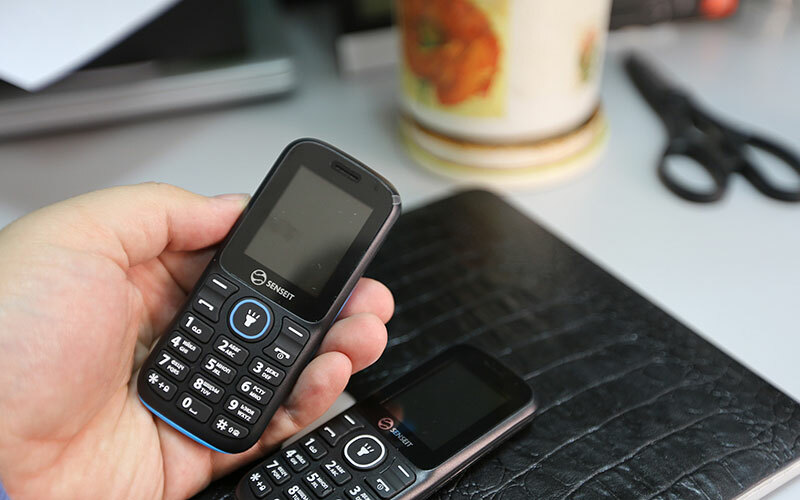Contents:
- How often should I clean the air conditioner?
- What should I clean in the indoor and outdoor units?
- Air filters
- Drainage system
- Fan
- Radiator and heat exchanger
- External unit
- Why contact the service center?
Knowing how to clean the air conditioner yourself, you can save a lot on maintenance of climate technology. Is it possible to wash all the elements - evaporator, radiator and fan - at home? The answer to this question depends on the design of the split system and the degree of contamination. To prevent a large accumulation of dirt and the formation of fat film, you need to clean the equipment at home as often as indicated in the instructions, then you do not have to remove the air conditioner and perform deep cleaning in the service center.
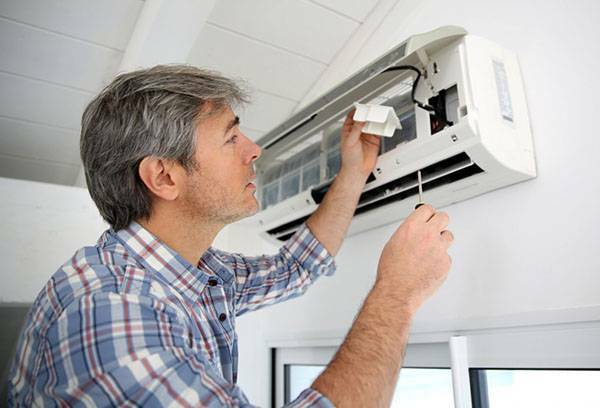
How often should I clean the air conditioner?
Manufacturers of climate equipment specify in the technical documentation how often it needs to be cleaned. It should be noted that different elements are served at different intervals. Most often it is necessary to clean air( dust) nets, because they accumulate dust, animal hair - any mechanical particles that are available in the air of the apartment. The frequency of cleaning here depends on the general pollution in the room, but it should not be made less than once a month.
Other components of the split system also need regular maintenance. It is recommended to perform it approximately every 6-12 months, depending on the intensity of the system. At home( not in industrial conditions) it is quite enough to perform cleaning procedures once a year.
There are symptoms indicative of contamination of the air conditioner:
- crackling or more loud operation of the split system;
- gurgling or squelching sounds;
- unpleasant smell, which appears after the air conditioning;
- water is dripping from the indoor unit.
Their appearance indicates that the cleaning is not performed or is not performed in full. With such manifestations, complex processing is necessary. It can be carried out at home, on its own or with the help of specialists.
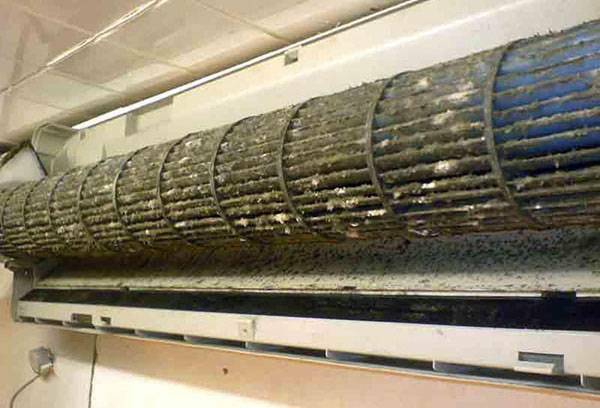
What should I clean in the indoor and outdoor units?
The air conditioner( split system) consists of two blocks - indoor, indoor, and outdoor - located on the outside wall of the house.
In the indoor unit are located:
- filters;
- fan;
- radiator and heat exchanger( evaporator);
- drainage system( bath and canal).
The condenser and compressor are delivered to the external unit, but there is also a heat exchanger and a fan, which also need regular maintenance, since there are fluff, leaves, wool and dust.

Air filters
Filters( dust mesh) must be cleaned frequently, as this prevents dirt from entering other parts of the system. It's easy to do this, and once figuring out, any user at home can handle it. The filters are located immediately below the top cover and visually look like a fine mesh with plastic partitions. They can be from one to three in one block.
The procedure consists of several actions:
- disconnect the power supply;
- lift the lid and lock it in the up position;
- remove the filters;
- clean the filter with a vacuum cleaner or brush and rinse under cold water;
- should be dried and replaced.
Filters can be either flat or curved( drum type).The cleaning method does not affect this.
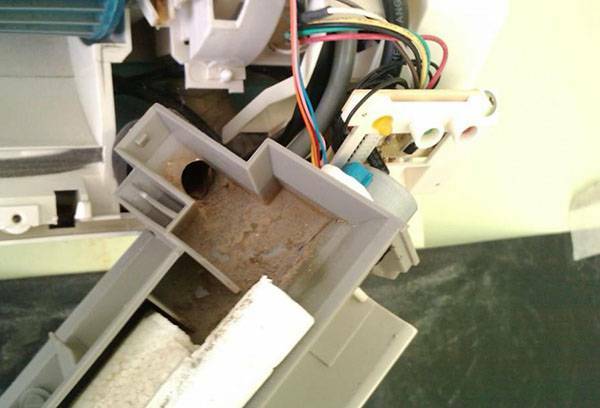
Drainage system
The drainage system consists of two elements - a tray( tray), where the liquid is collected from the heat exchanger, and a drainage pipe - the channel through which the liquid is withdrawn from the house. In order to remove the pallet, you must first remove the plastic housing of the indoor unit. It is attached with a few screws( mostly 3-4).Next, you need to remove the connector that connects the tray to the board, and detach it from the drain pipe.
The bath and the channel are then cleaned. The bath is thoroughly rinsed under running water. The drainage channel is blown by a stream of air under pressure - the compressor or the vacuum cleaner working on a blowing out is connected to a drainage branch pipe. Further into the channel it is necessary to pump chlorhexidine( 400 ml) and wait 10-15 minutes. After that, the channel is blown again.
Tip To verify that the drainage system has been completely cleaned at home, pour 1.5 liters of water to check. If there are no leaks, the cleaning is done well.

Fan
The fan can be cleaned in two ways. The first one is less efficient, but it will suit those who do not have the model and fixing of the air conditioner to remove the impeller( drum of the fan) and perform a thorough cleaning.
- After removing the filter, blow out dry dust with a vacuum cleaner, included in the blow-out, or with compressed air from the can.
- Apply a soap solution with a long pile brush on the drum blade. To handle all surfaces, the drum needs to be rotated by hand. As a washing solution, you can use any dish cleaner or laundry soap.
- After 5 minutes after applying the composition, it is necessary to turn on the air conditioner, pre-laying the film under the grille of the diffuser. At the same time, all the dirt will blow out.
You can additionally treat the blades with an antibacterial agent. Now on sale there are enough cleansing agents developed specially for climate control systems.
In most air conditioner models, it is possible to remove the impeller. In this case, it can be dropped completely into a soap solution, and then rinsed with a strong stream of water and thoroughly treated with a disinfectant.
The sequence of removal is as follows.
- Unscrew the front panel.
- Carefully remove the drainage bath so as not to spill the liquid there. In doing so, it must be disconnected from the board( remove the connector) and from the drain hose.
- Scroll the drum so that the locking screw is visible. It is located at the junction of the drum with the motor( there is no one blade).
- Remove the screw by gently bending the evaporator.
- After cleaning the drum assembly is carried out in reverse order.
Tip
If the impeller is blown off, the air conditioner can be damaged. This procedure is recommended only for people familiar with the technique.
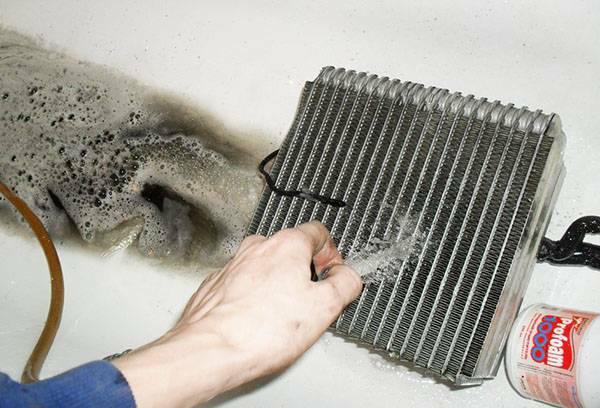
Radiator and heat exchanger
At home, the radiator and evaporator can be cleaned only superficially without removing them. Deep cleaning is carried out in the service centers with the removal of the indoor unit, and then reinstalled. The cost of such a procedure is considerable, so it is better to carry out regular maintenance on your own so as not to allow a strong accumulation of dirt on the air conditioner elements.
Step-by-step instruction
- Remove the top cover, air filters and unscrew the front panel.
- Clean the radiator and the evaporator with a long bristle brush. In this case, the movements should be only in the direction from the top down, otherwise the thin plates of the heat exchanger can be damaged.
- 0.5 liters of antiseptic is poured into the nebulizer, and the air conditioner is put into recirculation mode at the lowest possible temperature.
- Antiseptic spray in the suction zone( not on the radiator itself, but near it).
If a mud film forms on the heat exchanger, it can be removed with a steam cleaner. Dry dust must first be cleaned with a brush, and after cleaning steam should perform treatment with an antiseptic.
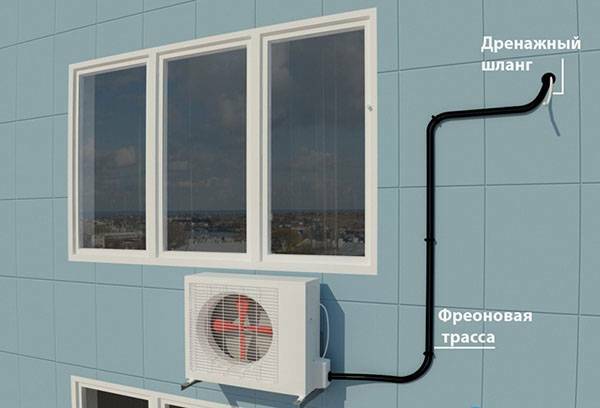
External unit
The outdoor unit is also susceptible to contamination, but there are practically no fat deposits. This simplifies the cleaning procedure.
- Disconnect the power supply.
- Remove the protective cover.
- Remove large debris with a brush or vacuum cleaner.
- Rinse the fan blades.
- Wash the external unit radiator from the hose or by using a steam generator. It should be ensured that water does not get into the electrical part of the unit.
Why contact a service center?
Despite the fact that the radiator and fan of the indoor and outdoor unit can be cleaned by yourself, this does not negate the maintenance. When operating the air conditioner, even in the most ideal conditions, a loss of refrigerant( freon or freon) occurs. Normally its quantity decreases by 5-7% per year. If there is a depressurization of the circuit, Freon may emit much more.


